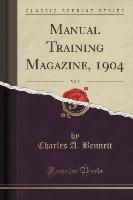Manual Training Magazine, 1904, Vol. 5 (Classic Reprint)
BücherAngebote / Angebote:
Excerpt from Manual Training Magazine, 1904, Vol. 5
By the fifth, or even the fourth grade, there is recognition of fine workmanship and finish. The fifth grade lad who, when remonstrated with for using his father's best linen handkerchiefs in which to wrap his fern-stand, said, You can get more handkerchiefs, but you can't get another fern-stand like this! Was typical. And every especially good piece of work receives hearty, even affectionate appreciation from the children.
The emphasis put by instructors in secondary schools on the educa tive value of the process per re may be the only sound principle for manual training in secondary schools, but in the elementary schools such emphasis would be fatal. Formal routine and discipline in manual training cannot be advantageously applied to young children. With regard to the attitude of the elementary manual training teacher towards technique, I have, then, two settled articles of belief. First, elementary manual training can never be approached from the point of View of technique, and can never be based on the value of processes as such. But, secondly, the elementary manual training approached from the point of view of individual interest can, and indeed will, result in a tech nique of surprising excellence. The work is not in any sense forced or unnatural. The excellence of technique comes through the joyous energy of the Children, their gay competition, their affection for the work, and their pride in doing it well.
About the Publisher
Forgotten Books publishes hundreds of thousands of rare and classic books. Find more at www.forgottenbooks.com
This book is a reproduction of an important historical work. Forgotten Books uses state-of-the-art technology to digitally reconstruct the work, preserving the original format whilst repairing imperfections present in the aged copy. In rare cases, an imperfection in the original, such as a blemish or missing page, may be replicated in our edition. We do, however, repair the vast majority of imperfections successfully, any imperfections that remain are intentionally left to preserve the state of such historical works.
Folgt in ca. 5 Arbeitstagen
